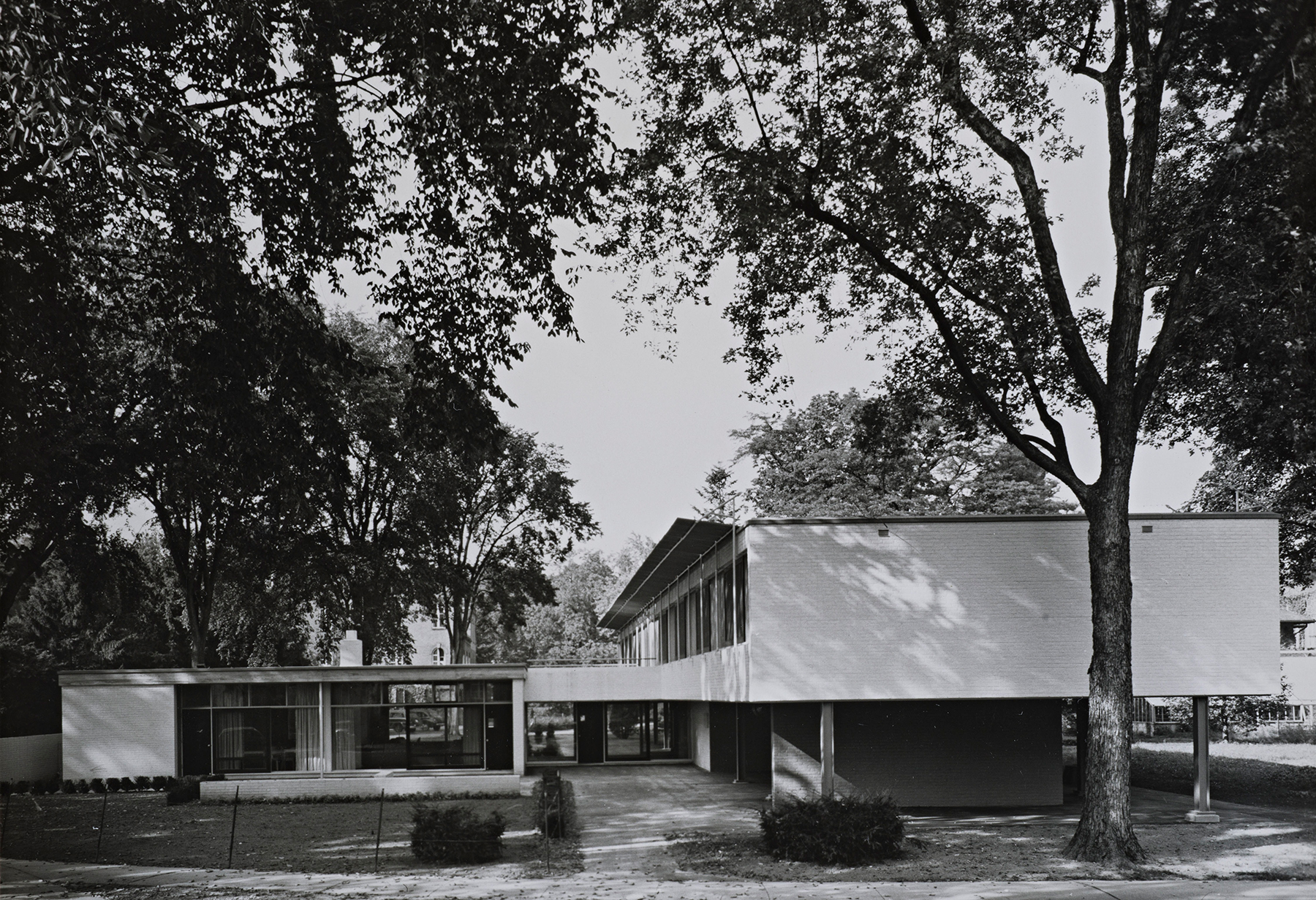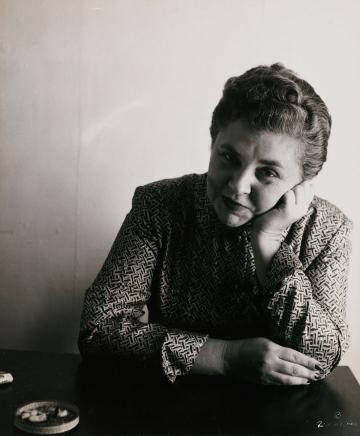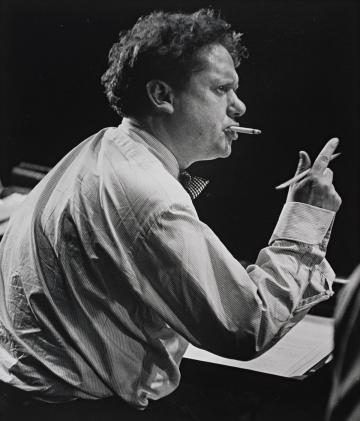A Vassar Homecoming for Photographer Rollie McKenna ’40
The unconventional life of Rollie McKenna (1918–2003) was largely thanks to her prolific career as a photographer, which afforded her both personal and professional independence. Photography allowed McKenna to travel the world and cultivate her craft free from the typical expectations of American women in the mid-twentieth century. Though she was essentially self-taught, in many ways her career began at Vassar, where she studied American history and art history and criticism.

Two years after graduating, she became a Navy officer. As the U.S. entered World War II, she enlisted in Women Accepted for Voluntary Emergency Service (WAVES) and became the first woman to attain the rank of sharpshooter in the Navy. In her autobiography, McKenna credited her maternal grandfather, in whose care she spent much of her childhood, for teaching her how to shoot. Her grandfather also instilled in McKenna a lifelong love of sailing, another experience that was formative for her as an adventurous, independent woman who did not conform to gendered expectations.

McKenna returned to Vassar in 1948 and 1949 to pursue a rare master’s degree in the history of art, with special dispensation under the G.I. Bill secured by art history professor Agnes Rindge Claflin. McKenna’s graduate study focused on the history of architecture and landscape architecture. Her master’s thesis, “A Study of the Architecture of the Main Building and the Landscaping of Vassar College, 1860–1870” (1949), remains the most comprehensive study of Vassar’s historic Main Building, designed by James Renwick Jr.
At age 30, McKenna discovered photography. In 1948, while traveling in Paris, she purchased her first professional camera. Her earliest experiments were photographing Italian Renaissance architecture at the suggestion of Vassar architectural history professor Richard Krautheimer. Thanks to her studies in the Art Department, McKenna was familiar with the work of Renaissance architects like Brunelleschi, Alberti, and Palladio. Her appreciation for the history of these structures, combined with careful attention to photographic processes and effects, immediately brought these pictures to the attention of architectural historians and their students across the United States.

As a student at Vassar—then one of the country’s few private colleges open to women—McKenna made invaluable professional connections. At the same time, she faced gender bias in a male-dominated profession, which required working exponentially harder to prove herself. A peripatetic childhood, spent shuffled between relatives, cultivated her sense of adventure, anchored by lifelong friendships, many of which began at Vassar.
One of those friends was Ruth Adams ’39, who graduated a year before McKenna and later became Editor-in-Chief of America Illustrated, the Russian-language magazine published by the U.S. Information Agency for distribution in the Soviet Union during the Cold War. During her time at the magazine, Adams frequently hired her college friend to create photo essays about the rapid cultural transformation occurring in New York, which led McKenna further into the world of architecture. Her work with Adams gave her the editorial freedom to co-create stories she felt passionate about.
One example of their work together is a major, four-part story to celebrate the reopening of the Museum of Modern Art after a fire in 1958. The two friends worked closely on all parts of the story, carefully selecting aspects of the museum to feature and determining how McKenna’s photographs would bring those to light.

The same year as the fire at the Museum of Modern Art, construction of the iconic Seagram Building was completed just a few blocks away. The project was overseen by Phyllis Lambert ’48, another illustrious Vassar alum who had graduated a few years after McKenna. Lambert commissioned modernist architects Ludwig Mies van der Rohe and Philip Johnson to design the modernist skyscraper. This high-profile project effectively launched Lambert’s distinguished career in architecture. The following year, this extraordinary achievement was honored in the Vassar Quarterly. Lambert commissioned McKenna to photograph the building’s exterior, and several of McKenna’s photographs were printed in the issue.
Lambert remembers holding McKenna in high esteem: “I recall that it was not only that she walked around always with a camera, but my admiration, and perhaps surprise, [at seeing] a graduate as a professional. In the late 1940s, this seemed extraordinary.” Some 70 years later, Lambert remembers McKenna as a young photographer who exuded an air of professionalism that left a lasting impression and would drive her career forward.

McKenna’s bread and butter was portrait photography. She photographed countless poets and writers on commission for editorials, book covers, and dust jackets. One of her mentors at Vassar, Professor Claflin, connected McKenna to artists like Alexander Calder and to the Museum of Modern Art, where McKenna contracted as an in-house photographer for many years. Vassar continued to be a home away from home for McKenna; she was commissioned by the College to photograph campus architecture, student life, and special events over the years. These pictures are now part of Vassar Libraries Archives and Special Collections. Given how formative Vassar was for McKenna’s career, it is no wonder that today she is the single most represented photographer in the collection of the Frances Lehman Loeb Art Center with over 200 photographs.
Likewise, it is fitting that this photographer’s first career retrospective exhibition, Making a Life in Photography: Rollie McKenna, is organized and hosted by her alma mater. The exhibition, on view at the Loeb through June 2, is presented thematically in four galleries and features more than 100 of McKenna’s photographs spanning her career, including portrait, architectural, and documentary photographs. Exhibition themes include People & Places, McKenna’s Modernism, Life & Photography, and McKenna at Work, while other issues such as artistic legacy, the complexities of privilege, and resistance to conventions of both womanhood and photographic genre are addressed. The exhibition is accompanied by a fully illustrated catalogue.
Jessica D. Brier is Curator of Photography and Mary-Kay Lombino is the Deputy Director and Emily Hargroves Fisher ’57 and Richard B. Fisher Curator at the Loeb. Making a Life in Photography: Rollie McKenna is generously supported by the Rosalie Thorne McKenna Foundation and the Hoene Hoy Photography Fund.

Attributions, from top:
Rollie McKenna, Vassar College, Ferry House—Exterior, 1951, Gelatin silver print, Frances Lehman Loeb Art Center, Vassar College, Gift of the artist, 1987.53.99.
Unidentified photographer, Rollie McKenna, 1960, Ingalls Hockey Arena, Yale University. Rosalie Thorne McKenna Collection, Center for Creative Photography, University of Arizona.
Rollie McKenna, Elizabeth Bishop, 1954, Gelatin silver print, Frances Lehman Loeb Art Center, Vassar College, Gift of the artist, 1987.53.35.
Rollie McKenna, Dylan Thomas, 1953, Gelatin silver print; printed 1983, Frances Lehman Loeb Art Center, Vassar College, Purchase, Francis Woolsey and Helen Silkman Bronson, class of 1924, Fund, 1983.6.
Rollie McKenna, Seagram Building, New York City, 1958, Gelatin silver print, Frances Lehman Loeb Art Center, Vassar College, Gift of the artist, 1987.53.94
Unidentified photographer, Rollie McKenna, date unknown, Stonington Historical Society.